It was calmer and brighter upon getting up and we swiftly
headed for Da Gardins of Sand to see what we could unearth without the trees
thrashing around avoiding the showers rattling through to the north.. The answer was very quickly obvious – not a lot. The Goldcrests were still around and a
Yellow-browed Warbler actually showed well for the first time all week although
it was giving some very odd abbreviated calls which we should have really recorded.
Four Siskins flew around and a single male House Sparrow was seen. We drove down to the old church ruins and
watched an Otter in the bay along with both Grey and Harbour Seal, auks and a Red-throated
Diver.
 |
| Coming down - not going up |
The weather was closing in yet again and was fully grey by
the time we skirted Tresta Voe where 15 adult Whooper Swans bobbed in the
middle having seemingly just stopped for a breather. From here we headed south towards Quendale
and ignored the fact that Graham Etherington had found another Myrtle Warbler
in Bigton – quite astonishing.
 |
| Whooper Swans |
The heavens opened on the way through Cunningsburgh and we were glad to be in the car still at that point.
It moved very quickly out to sea to the east where the sky and water
became one.
David may have been just about to mention that he could see blue sky ahead...
Another squall greeted us at the Mill and we sat it out for
a few minutes before then having to shelter by the out building from the next
one while six Swallows hawked around our heads.
 |
| Nap between squalls |
We slogged up the valley with Gary Gardiner and Clive Johnson but try as
we might we could not find the Siberian Stonechat and periodically we had to
take shelter from the lashing deluges that sped over the hill and down towards us. The iris beds have never been so welcoming. Two
flocks totalling 69 Barnacle Geese and 32 Greylags moved south and just a few
Meadow Pipits, Skylarks, Blackbirds and Starlings were seen otherwise.
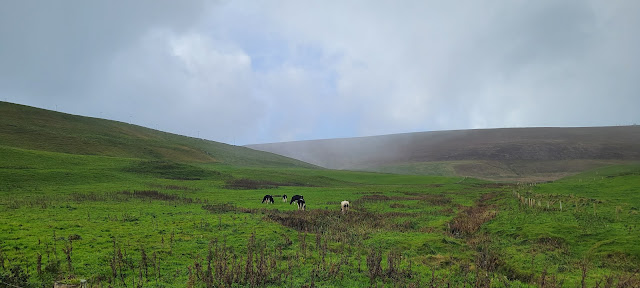 |
| Incoming |
 |
| It were grim |
 |
| Five minutes later |
A family of six Whoopers were on Loch of Hillwell on the way
back out but the Hornemann’s Redpoll at Toab did not play ball (story of the
week) although Merlin and Wheatear were both new to the trip tally and 18
Barnacle Geese arrived in a mixed flock with 26 Greylags.
 |
| Looking across to Garths Ness |
 |
| Over Virkie to Sumburgh |
 |
| The only Wheatear of the trip |
 |
| Barnacles and Greylags |
 |
| Barnacle Geese |
We checked the waders on the dropping tide at Virkie and
were pleased to find 18 Sanderling, 40 Ringed Plover, 20 Dunlin, four Bar-tailed
Godwit, Curlews, Redshank, Oystercatchers and Turnstones to sift through but
only a tiny ginger Ruff was discovered along with a juvenile Shelduck. Offshore to the south 83 Barnacle Geese came
up off Little Holm and continued south towards the distant Fair Isle.
 |
Barnacles leaving Little Holm
|
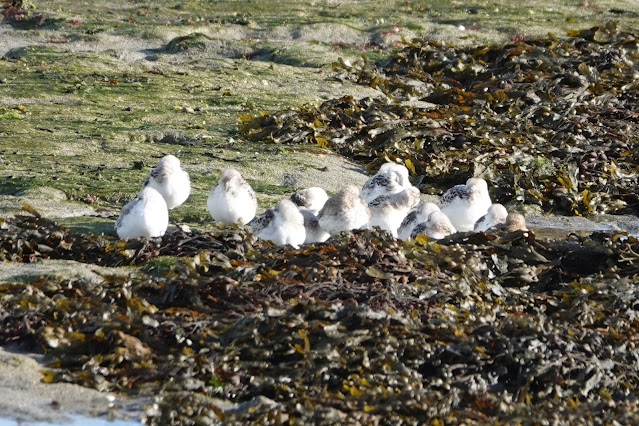 |
| Sanderling and Dunlin |
 |
| Incoming Helicopter and Greylags |
The second Myrtle Warbler was calling so we headed back up
to Bigton stopping briefly to take some scenic shots looking back to Colsay and
Scousburgh – little did we know we would be back there very soon. The walk down
to Ireland from the village involved some serious bog wading and fence
clambering to get to the small group of pines that Graham had been diligently
checking.
 |
| Scousburgh |
This brighter bird was seen immediately and over he next
half hour gave views at down to a few feet as it fed low in the pines and in
the grassy tussocks. There was a hint of more steely blue in the wings and tail and there were yellow shoulder epaulettes
and a hint of one or two yellow crown feathers if it fluffed them up. It was also quite vocal, making soft little
chip calls.
 |
| Butterbutt |
 |
| Myrtle Warbler #2 |
 |
| Myrtle Warbler #2 - Peter Moore |
We sloshed our way back out and were most of the way back up
the steep road to the car when David got breaking news of possible Least Bittern in the beach car park
at Scousburgh. The gap between him and
us increased but at least when he got the car he stopped to pick us up at the
top.
Just a few tense minutes later the car was thrown into the
mini car park and there may have been some slightly faster than usual movement
towards the end of the adjacent track.
About a dozen people were present and the bird had walked into the grass
shortly before anyone else got there but with some assistance from Team REV we
all soon had a good look at this chestnut ball of a tiny heron as it crouched
in the Marrams. It momentarily lifted its head and I then moved out of the way
to let new people in. Within a couple of
minutes it had shuffled back into the grass further and a mere brown patch
could be seen by subsequent arrivals.
 |
| that first view and tentative eyeball |
 |
| And a bit better from Andy Lawson |
 |
| The first few arrivals after us |
I moved up onto the out bank of the car park to give myself a better view should it fly although like many I suspected that it would probably succumb where it sat before too long. It was actually now only visible from one spot and the queue of hopefuls steadily grew and at times it may have got a little fractious with people trying to squeeze in in the front.
 |
| The queue grows down the lane to look through a telescope for ten seconds |
Thankfully common sense prevailed and it was agreed that the
bird needed to be taken into care as soon as possible. The crowd was moved well back and Phil Harris approached
the spot cautiously before picking up this new bird to Britain.
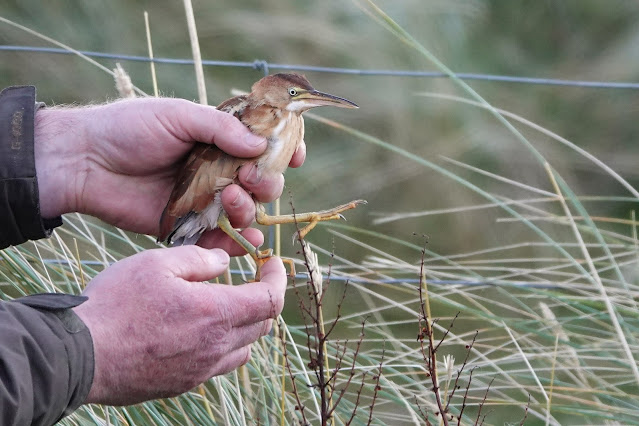 |
| Least Bittern - truly dinky |
Two minutes were spent walking past the assembled birders
before it was popped into a ringing bag and taken off to the local wildlife
hospital to a round of appreciative applause.
To see this special bird in the hand was a memorable experience of
conflicting emotions.
.JPG) |
| Least Bittern |
We had been very fortunate to be so close when the news
broke, others on the outer isles were not so lucky; we got the opportunity to
marvel at a new bird that had managed to navigate the raging Atlantic to reach
far flung Shetland but also knew that it was quite likely doomed to perish
given its exhausted state. Indeed it did not survive the night weighing in at just 50g
as opposed to its 86g fighting weight.
We finished up this memorable day back at Myrtle #1 but the
light was fading and although we could hear it ‘chipping’ we could not see it in
the Sycamores.























.JPG)















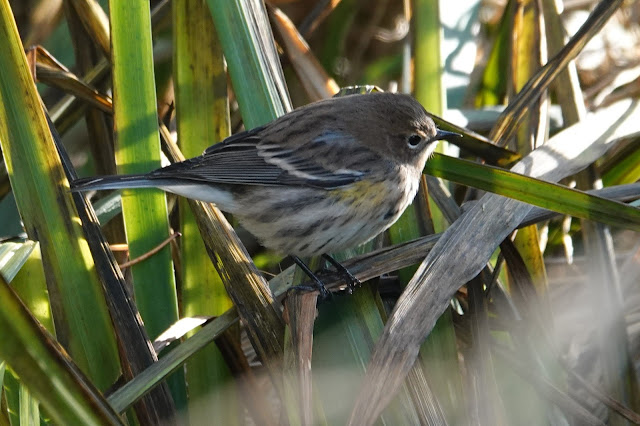

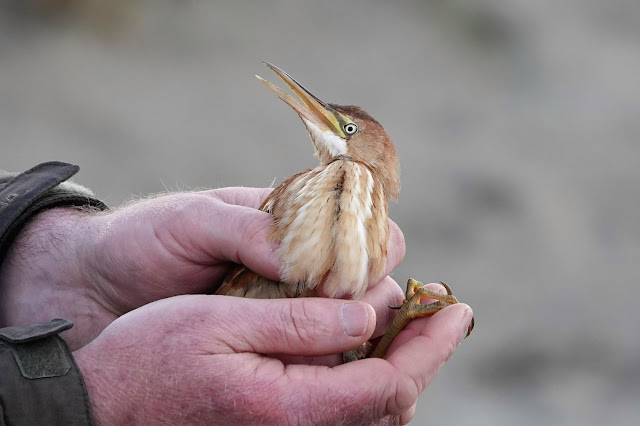

No comments:
Post a Comment